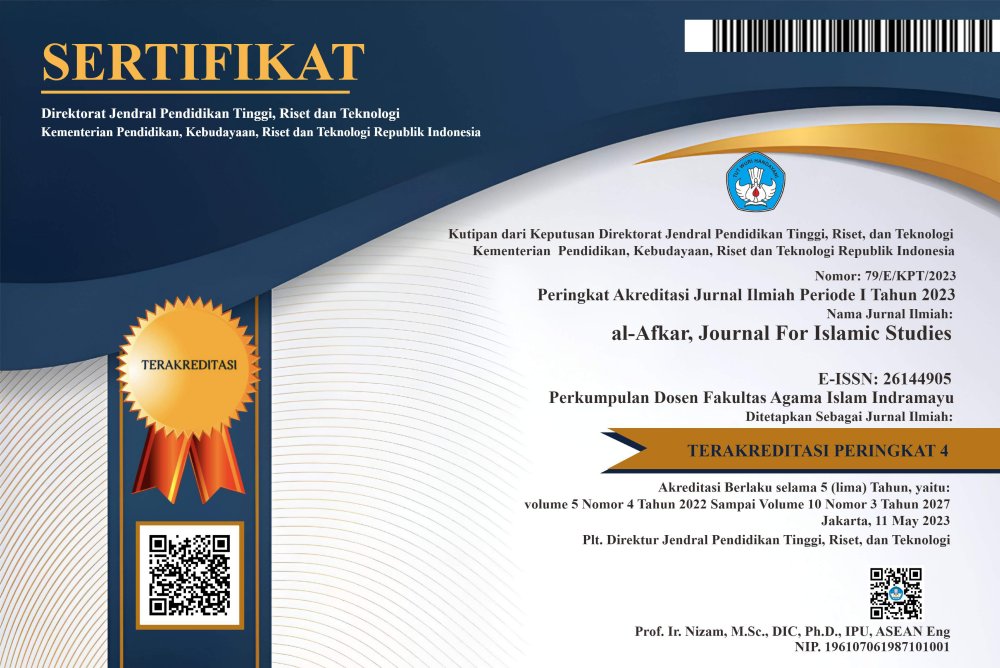جماليات التكوينات الخطية والوحدات الزخرفية الإسلامية: باب الكعبة المشرفة أنموذجا
DOI:
https://doi.org/10.31943/afkarjournal.v7i2.834Keywords:
الجمال, الخط العربي, الزخارف الإسلامية, باب الكعبة المشرفة, العهد السعوديAbstract
يعتبر باب الكعبة المشرفة تحفة فنية إسلامية فريدة من نوعها، ولذلك تهدف هذه المقالة إلى التعرّف على جمالية الخط العربي والوحدات الزخرفية الإسلامية المتجسدة في باب الكعبة المشرفة في العهد السعودي، وفقًا لمنظور منهجي تحليلي بغية الكشف عن فاعلية مبادئ التصميم الفني في تعزيز من جمالية باب الكعبة المشرفة، إن باب الكعبة المشرفة يحتوي على العديد من القيم الفنية والجمالية التي أضافت إليه جمالاً وفخامةً إيقاعية بصرية وعززت الإحساس بالقيمة الفنية الجمالية والروحية للخط العربي والوحدات الزخرفية الإسلامية. وستسلك الباحثة في هذه الدراسة منهج تحليل المحتوى الهيكلي، وذلك لأن هذا المنهج يهدف إلى الدراسة والتحليل بناءً على منظور الشكل الخارجي. وقد توصلت الباحثة إلى نتائج كثيرة، من أهمها ما يأتي: أنّ جمالية الخط العربي نابعة من توظيف خط الثلث في جملة التكوينات الخطية ذات الطابع الهندسي في باب الكعبة المشرفة. تنوعت الوحدات الزخرفية الإسلامية ما بين الأوراق النباتية، والشمسات، والأشرطة الزخرفية، مما عزّز من المنظور الجمالي للتصميم الكلي للباب. وتقترح هذه المقالة تشجيع الباحثين وخصوصاً الفنانين التشكيلين على إجراء مزيد من البحوث والدراسات الفنية التحليلية التي تكشف للمعنين بالفن الإسلامي كيفية استخدام الأساليب الفنية المعاصرة
Downloads
References
Al- Quran.
Al- Jabouri, Mahmoud Shukry. (2005). Research and articles on Arabic calligraphy. Dar Al Sharq Printing, Beirut, Lebanon.
Al-Jubouri, Mahmoud Shukr. (1998). Arabic calligraphy and Islamic decoration - values and concepts. Dar Al-Amal for Publishing and Distribution, Irbid, Jordan.
Al- Kurdish, Muhammad Tahir. (2000). Straight history. Investigation by Abd al-Malik bin Dahisha, Khader House for Printing and Publishing, Beirut, Lebanon
Al-Hussaini, Iyad Hussein Abdullah. (2003). The technical composition of Arabic calligraphy according to the principles of design. General Cultural Affairs House, Baghdad, Iraq.
Al-Farouqi, Ismail. (1999). Islam and art. Translated by Wafa Ibrahim, Dar Gharib, Cairo, Egypt.
Al- Azraq, Abu Walid. (1995). History of Mecca. Group of four professors, Commercial Library, Riyadh, Saudi Arabia.
Al-Musawi, Shawky. (2013). Aesthetic values of geometric figures in Qur'anic manuscripts. Dean’s Scientific Journal, Issue 5, University of Babylon, Iraq, Baghdad.
Al-Hathy Nasser Bin Ali. (2002). The door of the honorable Kaaba during the reign of King Abdulaziz. Quarterly Refereed Magazine published by King Abdul-Aziz House, Fourth Issue, Twenty-eighth Year, Makkah Al-Mukarramah, Kingdom of Saudi Arabia.
Basalamah, Hussein. (1999). History of the Great Kaaba, its architecture, clothing, and obesity. Achieve d. Youssef bin Ali Al-Thaqafi, printed on the occasion of the centenary.
Hamidi, Abdul Jabbar. (2005). Arabic calligraphy and Arab Islamic decoration. House of Affairs, Kingdom of Jordan.
Hanash, Adham. (2013). Islamic art theory aesthetic concept and cognitive structure. The Scientific Institute of Islamic Thought, The Hashemite Kingdom of Jordan, Amman, Jordan.
Hassan, Zaki Muhammad. (1956). Atlas of Islamic Art and Decorative Painting. Baghdad, Iraq.
Ibn Fahd, Omar bin Fahd the star. (1982). Al-Rai news in Umm Al-Qura news Investigated by Fahim Bin Shaltout, published by the Center for Scientific Research, Umm Al-Qura University, Makkah Al-Mukarramah, Kingdom of Saudi Arabia.
Khalaf, Masum Muhammad. (1998). The universality of Arabic calligraphy. Arab Writers Union, Damascus, Syria.
Sagar, Iyad. (2003). Islamic Arts. Dar Majdalawi, Baghdad, Iraq.
Downloads
Published
How to Cite
Issue
Section
License
Copyright (c) 2024 Duaa Alashari

This work is licensed under a Creative Commons Attribution 4.0 International License.



















